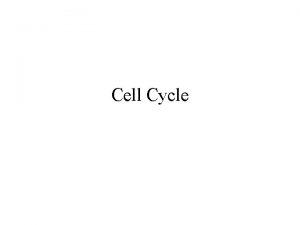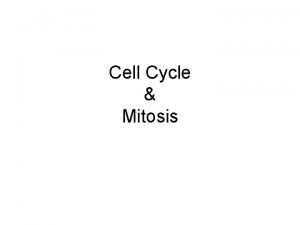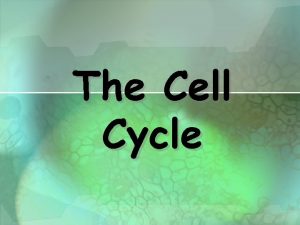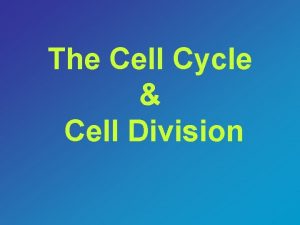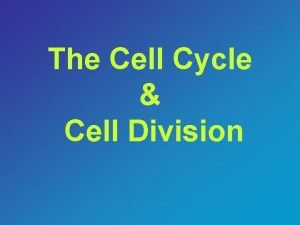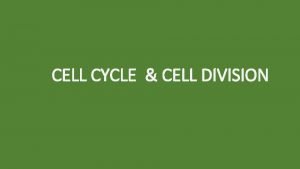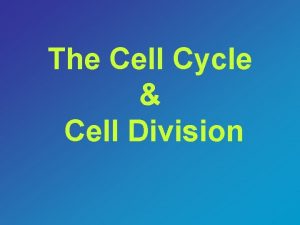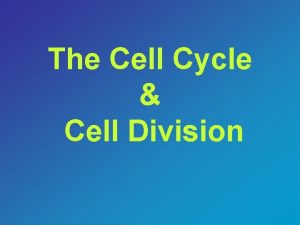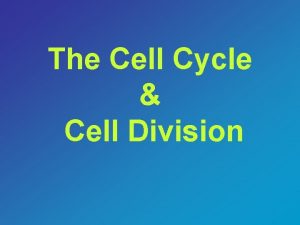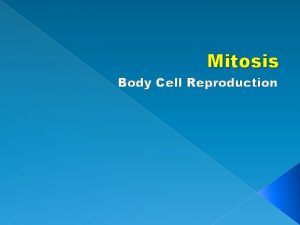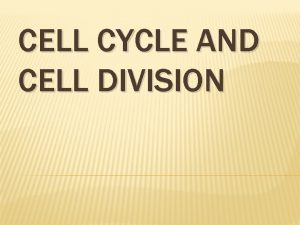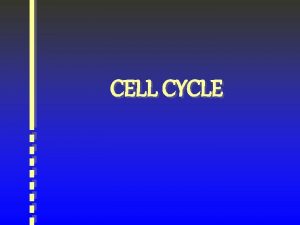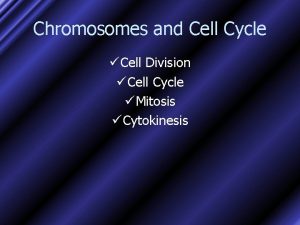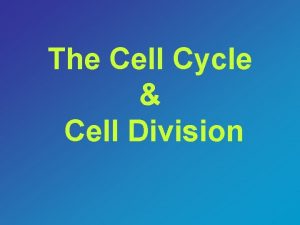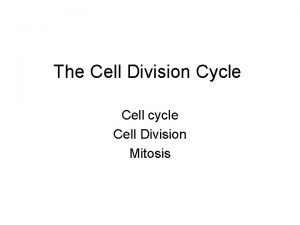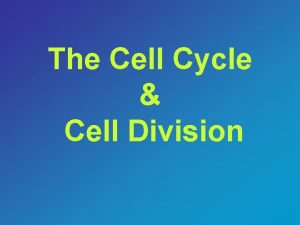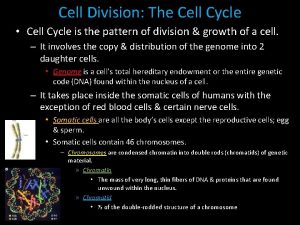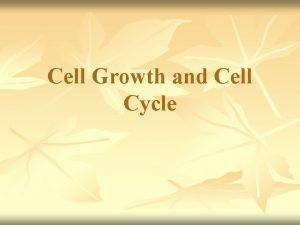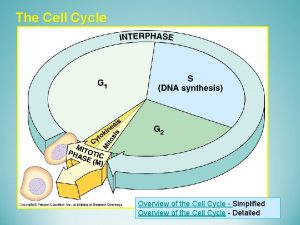Chapter 17 The Cell Cycle An Overview of

















































- Slides: 49

Chapter 17 The Cell Cycle













An Overview of the Cell Cycle 1. The eucaryotic cell cycle is divided into four phases 2. Cell-cycle control is similar in all eucaryotes 3. Cell-cycle control system dissected genetically in yeasts 4. Cell-cycle control system analyzed biochemically in animal embryos 5. Cell-cycle progression studied in various ways

The major events of the cell cycle

Events of eucaryotic cell division as seen under a microscope

The four phases of the cell cycle

Cell-cycle control system dissected genetically in yeasts

Behavior of a temperature-sensitive Cdc mutant room temperature 36°C

Morphology of budding yeast cells arrested by a Cdc mutation Normal yeast cells – buds vary in size according to the cell-cycle stage In a Cdc 15 mutant, grown at the restrictive temperature, cells complete anaphase but cannot complete the exit from mitosis and cytokinesis. They arrest uniformly with the large buds, which are characteristic of late M phase

Cell-cycle control system analyzed biochemically in animal embryos A mature Xenopus egg, ready for fertilization

Oocyte growth and egg cleavage in Xenopus

Studying cell cycle in a cell-free system

Cell-cycle progression studied in various ways Labeling S-phase cells

Analysis of DNA content with a flow cytometer

The cell-cycle control system 1. Cell-cycle control system triggers the major events of the cell cycle 2. The cell-cycle control system depends on cyclically activated cyclindependent protein kinases (Cdks) 3. Inhibitory phosphorylation and Cdk inhibitory proteins (CKIs) can suppress Cdk activity 4. The cell-cycle control system depends on cyclical proteolysis 5. Cell-cycle control also depends on transcriptional regulation 6. The cell-cycle control system functions as a network of biochemical switches

Control of the cell cycle

Two key components of the cell-cycle control system

Cyclin-Cdk complexes of the cell-cycle control system


Inhibitory phosphorylation and Cdk inhibitory proteins (CKIs) can suppress Cdk activity The structural basis of Cdk activation

The regulation of Cdk activity by inhibitory phosphorylation

The inhibition of a cyclin-Cdk complex by a CKI

The cell-cycle control system depends on cyclical proteolysis


Cell-cycle control also depends on transcriptional regulation In budding yeast, about 10% of the genes encode m. RNAs whose levels oscillate during the cell cycle

The cell-cycle control system functions as a network of biochemical switches

An overview of the cell-cycle control system

The two central events of the cell cycle are: - replication of DNA during the S phase - chromosome segregation and cell division during the M phase Both these events are controlled by the cyclin-Cdk complexes

S phase 1. S-Cdk initiates DNA replication once per cycle 2. Chromosome duplication requires duplication of chromatin structure 3. Cohesins help hold sister chromatids together

Control of chromosome duplication

Control of the initiation of DNA replication The ORC remains associated with the ori site throughout the cell cycle. In early G 1, Cdc 6 and Cdt 1 (helicase loading proteins) associate with the ORC and the resulting complex allows the assembly of the Mcm ring and the formation of the prereplicative complex. In the S phase, S-Cdk stimulates the assembly of several additional proteins to form the preinitiation complex. Other proteins are recruited to the origin and replication begins. S-Cdk blocks rereplication by triggering the destruction of Cdc 6 and the inactivation of the ORC. The cell is able to assemble the pre-RC only after M-Cdk is inactivated and APC/C is activated at the end of the M-phase

S-Cdk activity is high during G 2 and early mitosis. This prevents rereplication from occurring after the S phase M-Cdk also prevents rereplication from occurring during mitosis by phosphorylating the Cdc 6 and ORC proteins With all the control elements preventing rereplication, how does DNA replication take place in the next cell cycle? At the end of mitosis, APC/C activation leads to the inactivation of Cdk activity and the destruction of geminin. Pre-RC components are dephosphorylated and Cdt 1 is activated allowing pre-RC assembly to initiate a new round of replication

Mitosis 1. M-Cdk drives entry into mitosis 2. Dephosphorylation activates M-Cdk at the onset of mitosis 3. Condensin helps configure duplicated chromosomes for separation 4. The mitotic spindle is a microtubule-based machine 5. Centrosome duplication occurs early in the cell cycle 6. M-Cdk initiates spindle assembly in prophase 7. The completion of spindle assembly in animal cells requires nuclear envelope breakdown 8. The APC/C triggers sister-chromatid separation and the completion of mitosis 9. Unattached chromosomes block sister-chromatid separation: The spindle assembly checkpoint

Activation of M-Cdk drives entry into mitosis

The APC/C triggers sister-chromatid separation and the completion of mitosis

Control of cell division and cell growth

Mechanism controlling cell-cycle entry and S-phase initiation in animal cells

How DNA damage arrests the cell cycle in G 1
 Section 10-2 cell division
Section 10-2 cell division Cell cycle and cell division
Cell cycle and cell division Biology.arizona.edu/cell bio/activities/cell cycle/01.html
Biology.arizona.edu/cell bio/activities/cell cycle/01.html Steps of cell cycle
Steps of cell cycle Cell signaling overview
Cell signaling overview The scientist mathias schleiden studied _______ in ______.
The scientist mathias schleiden studied _______ in ______. Chapter 5 two-cycle and four-cycle engines answers
Chapter 5 two-cycle and four-cycle engines answers Hình ảnh bộ gõ cơ thể búng tay
Hình ảnh bộ gõ cơ thể búng tay Lp html
Lp html Bổ thể
Bổ thể Tỉ lệ cơ thể trẻ em
Tỉ lệ cơ thể trẻ em Gấu đi như thế nào
Gấu đi như thế nào Chụp phim tư thế worms-breton
Chụp phim tư thế worms-breton Chúa sống lại
Chúa sống lại Môn thể thao bắt đầu bằng chữ đua
Môn thể thao bắt đầu bằng chữ đua Thế nào là hệ số cao nhất
Thế nào là hệ số cao nhất Các châu lục và đại dương trên thế giới
Các châu lục và đại dương trên thế giới Công thức tiính động năng
Công thức tiính động năng Trời xanh đây là của chúng ta thể thơ
Trời xanh đây là của chúng ta thể thơ Mật thư tọa độ 5x5
Mật thư tọa độ 5x5 Làm thế nào để 102-1=99
Làm thế nào để 102-1=99 độ dài liên kết
độ dài liên kết Các châu lục và đại dương trên thế giới
Các châu lục và đại dương trên thế giới Thơ thất ngôn tứ tuyệt đường luật
Thơ thất ngôn tứ tuyệt đường luật Quá trình desamine hóa có thể tạo ra
Quá trình desamine hóa có thể tạo ra Một số thể thơ truyền thống
Một số thể thơ truyền thống Cái miệng xinh xinh thế chỉ nói điều hay thôi
Cái miệng xinh xinh thế chỉ nói điều hay thôi Vẽ hình chiếu vuông góc của vật thể sau
Vẽ hình chiếu vuông góc của vật thể sau Thế nào là sự mỏi cơ
Thế nào là sự mỏi cơ đặc điểm cơ thể của người tối cổ
đặc điểm cơ thể của người tối cổ V cc cc
V cc cc Vẽ hình chiếu đứng bằng cạnh của vật thể
Vẽ hình chiếu đứng bằng cạnh của vật thể Tia chieu sa te
Tia chieu sa te Thẻ vin
Thẻ vin đại từ thay thế
đại từ thay thế điện thế nghỉ
điện thế nghỉ Tư thế ngồi viết
Tư thế ngồi viết Diễn thế sinh thái là
Diễn thế sinh thái là Dot
Dot Số nguyên tố là gì
Số nguyên tố là gì Tư thế ngồi viết
Tư thế ngồi viết Lời thề hippocrates
Lời thề hippocrates Thiếu nhi thế giới liên hoan
Thiếu nhi thế giới liên hoan ưu thế lai là gì
ưu thế lai là gì Hổ đẻ mỗi lứa mấy con
Hổ đẻ mỗi lứa mấy con Khi nào hổ con có thể sống độc lập
Khi nào hổ con có thể sống độc lập Sơ đồ cơ thể người
Sơ đồ cơ thể người Từ ngữ thể hiện lòng nhân hậu
Từ ngữ thể hiện lòng nhân hậu Thế nào là mạng điện lắp đặt kiểu nổi
Thế nào là mạng điện lắp đặt kiểu nổi A 23 year old male experienced severe head trauma
A 23 year old male experienced severe head trauma


















































